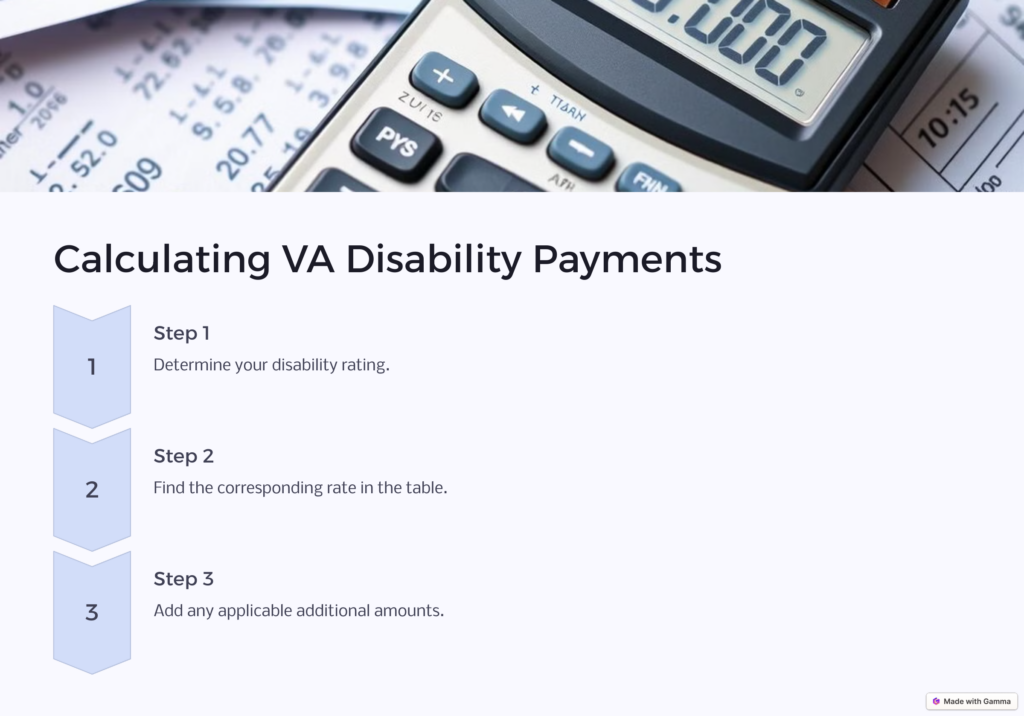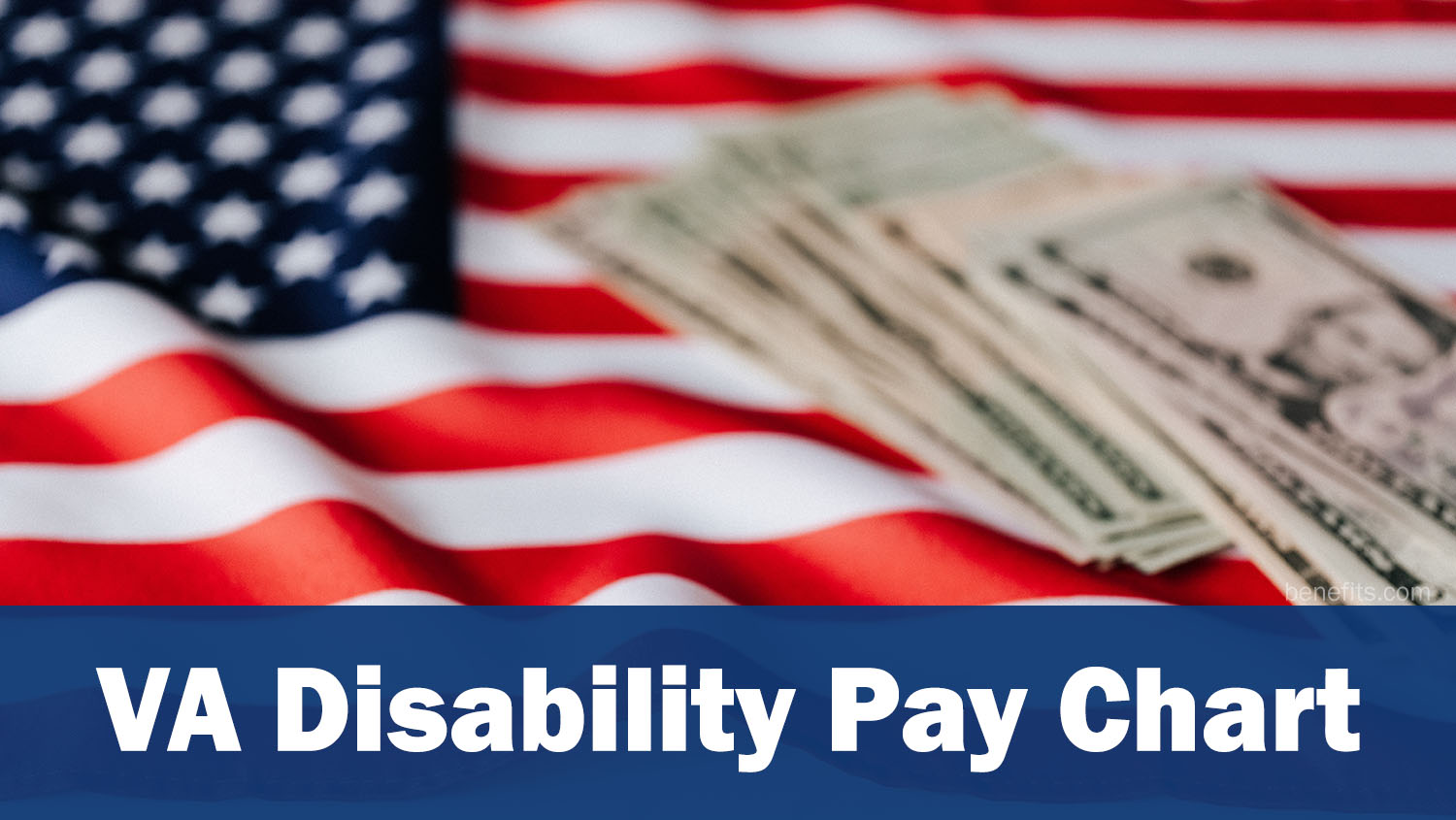Each year, the U.S. Department of Veterans Affairs examines and analyzes the rates at which it pays VA disability benefits. Based on economic trends, the VA may determine that these rates should be adjusted for inflation and rising costs.
The rates for 2026 increased by 2.8%.
COLA is determined each year by the Social Security Administration.
During the peak of the pandemic, support from the Federal Reserve gave the U.S. a helpful influx of cash. This federal financial support will decrease steadily to slow down the economy and stop the skyrocketing inflation.
2026 VA Disability Rates
Effective Date: December 1, 2025
Note: Veterans with a 10% to 20% disability rating do not receive additional compensation for having a spouse, dependent child, or dependent parent.
| Disability Rating | Monthly Payment |
| 10% | $180.25 |
| 20% | $356.32 |
VA disability compensation is based on the veteran’s disability rating and household.
| Disability Rating | Veteran (alone, no dependents) | With Spouse (no parents or children) |
| 30% | $551.93 | $617.19 |
| 40% | $795.06 | $882.44 |
| 50% | $1,131.79 | $1,241.27 |
| 60% | $1,433.62 | $1,565.20 |
| 70% | $1,806.69 | $1,959.32 |
| 80% | $2,100.10 | $2,274.84 |
| 90% | $2,360.00 | $2,556.85 |
| 100% | $3,934.74 | $4,154.12 |
| Disability Rating | With Spouse and 1 Parent (no children) | With Spouse and 2 Parents (no children) |
| 30% | $669.83 | $722.46 |
| 40% | $951.91 | $1,021.39 |
| 50% | $1,328.64 | $1,416.02 |
| 60% | $1,670.47 | $1,775.74 |
| 70% | $2,082.49 | $2,205.65 |
| 80% | $2,414.85 | $2,554.85 |
| 90% | $2,714.75 | $2,872.66 |
| 100% | $4,330.19 | $4,506.26 |
| Disability Rating | With 1 Parent (no spouse or children) | With 2 Parents (no spouse or children) |
| 30% | $604.62 | $657.20 |
| 40% | $864.54 | $934.02 |
| 50% | $1,219.17 | $1,306.54 |
| 60% | $1,538.88 | $1,644.15 |
| 70% | $1,929.85 | $2,053.01 |
| 80% | $2,240.10 | $2,380.10 |
| 90% | $2,517.90 | $2,675.81 |
| 100% | $4,110.81 | $4,286.88 |
| Disability Rating | With 1 Child (no spouse or parents) | With 1 Child and Spouse (no parents) |
| 30% | $595.09 | $665.62 |
| 40% | $852.96 | $946.65 |
| 50% | $1,204.43 | $1,321.28 |
| 60% | $1,520.99 | $1,660.99 |
| 70% | $1,908.79 | $2,071.96 |
| 80% | $2,216.94 | $2,403.27 |
| 90% | $2,491.59 | $2,701.07 |
| 100% | $4,081.45 | $4,314.78 |
| Disability Rating | With 1 Child, 1 Spouse, and 1 Parent | With 1 Child, 1 Spouse, and 2 Parents |
| 30% | $718.25 | $770.88 |
| 40% | $1,016.13 | $1,085.60 |
| 50% | $1,408.65 | $1,496.02 |
| 60% | $1,766,26 | $1,871.53 |
| 70% | $2,195.12 | $2,318.29 |
| 80% | $2,543.27 | $2,683.28 |
| 90% | $2,858.97 | $3,016.87 |
| 100% | $4,490.85 | $4,666.92 |
| Disability Rating | With 1 Child and 1 Parent (no spouse) | With 1 Child and 2 Parents (no spouse) |
| 30% | $647.72 | $700.36 |
| 40% | $922.44 | $991.91 |
| 50% | $1,291.80 | $1,379.17 |
| 60% | $1,626.26 | $1,731.52 |
| 70% | $2,031.96 | $2,155.12 |
| 80% | $2,356.95 | $2,496.96 |
| 90% | $2,649.49 | $2,807.39 |
| 100% | $4,257.52 | $4,433.59 |
Added Amounts
| Disability Rating | Each Additional Child Under Age 18 | Each Additional Child Over Age 18 in a Qualifying School Program |
| 30% | $32.63 | $60.00 |
| 40% | $43.16 | $80.00 |
| 50% | $53.69 | $100.00 |
| 60% | $65.27 | $120.00 |
| 70% | $75.79 | $246.33 |
| 80% | $86.32 | $281.06 |
| 90% | $97.90 | $316.86 |
| 100% | $109.00 | $352.11 |
| Disability Rating | Spouse Receiving Aid and Attendance |
| 30% | $60 |
| 40% | $80 |
| 50% | $100 |
| 60% | $120 |
| 70% | $141.06 |
| 80% | $161.06 |
| 90% | $181.06 |
| 100% | $201.21 |
How To Calculate Your VA Disability Payment

You can calculate your expected veteran’s disability benefits using the information provided by the VA. First, using the compensation tables presented here, find your VA compensation rate for your specific disability rating. Then, using the basic rates table, you should be able to find the appropriate amount for your disability rating and your dependent status.
You’ll notice in these charts that you can calculate benefits for just about any combination of household makeup and disability levels so that you can anticipate changes to your veteran benefits.
What Is COLA?

The U.S. Department of Veterans Affairs routinely evaluates its current rate for disability benefits to make sure benefit amounts are effectively keeping up with inflation. Any adjustment to benefit amounts based on this is known as a Cost of Living Adjustment. Federal law requires that any COLA adjustment to VA disability benefits be equal to the adjustment of Social Security benefits payments. This policy prevents inflation from limiting the value of the compensation.
As required by law, the need for and value of a COLA is determined by the percentage increase in the Consumer Price Index for Urban Wage Earners and Clerical Workers (CPI-W) from the third quarter of the most recent year a COLA was set to the third quarter of the current year.
The Bureau of Labor Statistics determines the CPI-W within the U.S. Department of Labor. If there is no CPI-W increase during an evaluation period, there will be no COLA. If any increase in the CPI-W is valued at a minimum of 0.1%, a COLA will be made. However, if the CPI-W increases by an amount less than 0.05%, or if the CPI-W decreases, there will be no COLA.
The COLA provision began as part of the 1972 Social Security Amendments, and automatic annual COLAs began in 1975 with legislation that ties COLAs directly to the annual CPI-W increase. Before this time, Social Security benefits increased only when Congress enacted special legislation, which occurred only on an ad hoc basis.
For 2026, VA and Social Security benefits are increasing by 2.8%, affecting millions of Americans who currently receive these benefits.
How Does the VA Determine Ratings?
To determine the amount of a veteran’s VA disability benefit, the VA needs to quantify the severity of the disability. When you submit a claim for VA disability benefits, you must include all relevant medical documentation and evidence about your medical condition. After a medical examination and thorough review of the medical evidence, the VA assigns a rating based on the severity of the veteran’s disability.
This VA disability rating ranges from 0 to 100% in 10-percent increments. The rating calculates the level of compensation the veteran will receive.
You can receive additional monthly compensation if you are severely disabled, have lost a limb, have a spouse who also is disabled—or if you have a spouse, dependent child, or dependent parent within your immediate household.
Sometimes, a veteran may submit a VA claim related to multiple disabilities. In these cases, the VA will use a combined rating table to determine a combined disability rating and VA benefit amount that reflects all rated medical conditions.
Combined ratings can be tricky since the percentages are not simply added together. It’s intuitive to think that if a veteran has one disability rated at 40% and another rated at 30%, the combined rating would be 70%, but that isn’t the case. So instead, the VA will first rank the disabilities in order of severity.
If you have multiple disabilities, the VA starts with your most severe disability rating. For additional disabilities, each lower rating is roughly cut in half before being added. The final percentage is rounded to the nearest 10%. For example, if a veteran has three disabilities: one disability rated at 40%, one at 30%, and another at 20%, the combined disability rating is roughly: 40% + 15% + 10% = 65%. That gets rounded up, so the final rating is 70%. You can use the combined rating table on VA.gov for a more precise calculation.
Any percentage that ends in 5 or higher is rounded up, not rounded down. For example, a 34% rating is rounded down to 30%, but a 35% rating is rounded up to 40%.
How Much Help Does 100% Disability Receive?
Veteran Affairs (VA) disability is also known as VA disability compensation (benefits). This is a non-taxed compensation awarded to veterans who have suffered an injury or become sick while serving in the military or those suffering from worsened conditions.
Veterans get VA disability compensation each month. Those with total disability get the 100 VA disability benefits, where 100 is 100%, which is the maximum VA benefit/rate.
Today, the 100% VA disability payment ranges between $3,900 and $4,700 based on a veteran’s specific condition and factors like the number of children, spouse, and age of the children. The amount a veteran can get largely depends on the level of disability. The payment is also scaled on a sliding scheduler rating system. The schedule ranges from 0% to 100%, with an increase of 10% for the perceived degree of disability.
Thus, the more disabling your situation is after serving in the military, the more disability benefits you will get. That is why the VA disability payment is also popularly known as a compensation rate.
The 100% rating is at the top of the compensation schedule, which means total disability and, thus, eligibility for the maximum compensation from the United States Department of Veteran Affairs.
This amount is adjusted yearly to account for any increase in the cost of living. If you have multiple service-related conditions, each condition will have its disability rate before a total combined amount is computed.
A veteran is allocated a 100% VA disability rating if:
- If they have one service-affiliated condition that checks the 100% rating criteria established for that condition, or
- If they have several service-connected conditions with separate disability ratings that add up to 100%.
The Aid and Attendance Benefit
The VA’s Aid and Attendance Benefit is designed to help lessen the financial burden of qualified veterans and/or their surviving family members who need additional help with day-to-day activities. This benefit is an additional payment added to existing disability benefit amounts.
Specifically, the Aid and Attendance program provides tax-free payments to veterans who served during wartime. In addition to veterans themselves, veterans’ surviving spouses (until remarriage) and dependent children also are eligible to receive Aid and Attendance benefits. To be eligible for this extra benefit, the veteran, their surviving spouse, or dependents must meet specified income and asset thresholds.
Aid and Attendance are one of the lesser-known VA benefits. It’s a VA medical rating that allows for additional financial support in the case of veterans, surviving spouses, or qualifying dependents who need the regular aid and attendance of a caregiver.
If a disabled veteran, surviving spouse, or dependent needs assistance with daily activities like bathing, feeding, and dressing, they may qualify for an Aid and Attendance benefit payment. In addition, if a veteran or family member is confined to a bed because of a rated, service-connected disability or medical condition and/or is a patient in a nursing home or suffers from limited eyesight, an additional Aid and Attendance benefit may be approved by the VA.
Specific eligibility requirements associated with Aid and Attendance include the following:
- The veteran must have served active duty for a minimum of 90 days. At least one of those days must have been during a war, defined by the VA to include World War II, the Korean conflict, the Vietnam era, and the Gulf War. For Gulf War veterans, service requirements are either 24 months of active duty service or the completion of an active-duty requirement, whichever comes first.
- The veteran must have been discharged under circumstances other than dishonorable.
- The veteran, under age 65, must be classified by the VA as totally disabled.
- Surviving spouses do not need to meet the criteria outlined above. Instead, they must have been married to the veteran at the time of the veteran’s death, be unmarried at the time of application, and not have remarried after November 1, 1990.
In addition, the veteran’s household income, or that of the surviving spouse, must fall below the Maximum Allowable Pension Rate (MAPR), which the VA defines. Finally, to be eligible for Aid and Attendance benefits, the veteran or surviving spouse must also show documentation that assets fall below acceptable limits, as defined by the VA—the current threshold stands around $160,000 in assets.
Find Out More With Benefits.com
No matter your question, we’re here to help with the latest information on all things regarding Veteran benefits. Check out our blog for more, and take our quiz today to find out for which benefits you qualify!
 Benefits.com Advisors
Benefits.com Advisors
With expertise spanning local, state, and federal benefit programs, our team is dedicated to guiding individuals towards the perfect program tailored to their unique circumstances.
Rise to the top with Peak Benefits!
Join our Peak Benefits Newsletter for the latest news, resources, and offers on all things government benefits.



















